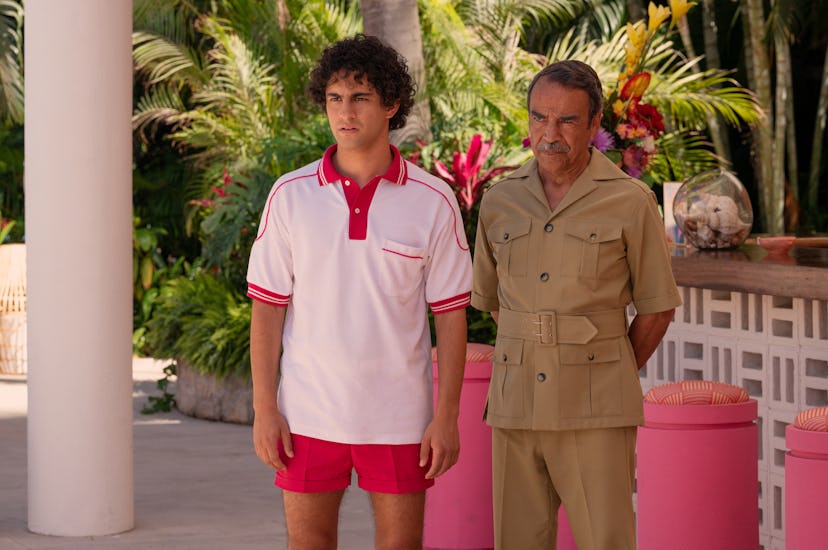Welcome to W TV Club, in which W magazine chooses a television show they’d recommend you binge-watch. Our December picks will be a selection of series that center the idea of friends and family—which happens to be the theme for our latest print issue, Volume 6. This week, writer Michel Ghanem, aka @tvscholar, recommends the colorful Apple TV+ dramedy, Acapulco.
Acapulco, a charming new bilingual comedy for Apple TV+, is the first show I watched this year that was about a resort but did not involve a grisly murder. Instead, the series, which is very loosely inspired by Ken Marino’s 2017 film, How to Be a Latin Lover, follows twenty-something Maximo (Eugenio Derbez) in 1984, our protagonist determined to rise up the ranks as a cabana boy at the resort of Las Colinas in Acapulco, Mexico.
Here, levity and optimism are not in short supply, which feels radical after making my way through Nine Perfect Strangers and The White Lotus, two of the most talked-about miniseries of the year that put viewers through the wringer when it comes to murder mystery red herrings. In some ways, Acapulco is a perfect follow-up to Ted Lasso, in that all of the characters are simply doing the best they can—for themselves and for their chosen family. In fact, both shows are grouped together under the “feel good comedies” section of the Apple TV+ app.
Each half-hour episode is structured by showing present-day Maximo as he narrates his rags-to-riches journey to his nephew, Hugo (Raphael Alejandro). Luckily, their exchanges are clever and entertaining, adding more depth to a frame story structure that might be alienating to How I Met Your Mother fans. We eventually find out that Maximo is a fairly unreliable narrator—a character’s name, for example, changes nine episodes into the season when Maximo realizes he remembered it wrong, and Hugo often pokes holes in Maximo’s storytelling. He paints his younger self (played by Enrique Arrizon) as bouncy and driven, obsessed with pleasing his superiors and completing bizarre quests to satisfy the resort clientele, like bartering with his coworkers to procure marijuana.
The series arc exists more in the vein of a Jane the Virgin style rom-com, centering a love triangle that involves Maximo’s attempts to woo his crush, Julia the receptionist, with the help of his friend Memo, who works in the laundry room. At home, Maximo’s sister Sara experiences her coming-of-gay-age and is the socialist voice of the series. Their religious mother, Nora, is in the midst of losing her vision and is very concerned about losing the family’s livelihood. Acapulco is not afraid to breathe life into its supporting players, which is always a sign of a quality comedy series. In one notably strong episode, the show jumps through multiple decades leading up to 1984 to illuminate what we don't yet know about how the resort and its characters came to be.
The pilot introduces us to the resort through Maximo’s eyes on his first day, and I found myself experiencing the hotel with the same awe. Las Colinas is bathed in color that fills the entire screen—from the lobby’s pink-red walls, to bright green office corridors, and accented everywhere by yellows, oranges, purples. “Pretty bodacious, right?” Chad (Chord Overstreet), the general manager and surfer-esque son of the owner, tells us during the tour. It brings to mind writer and artist David Batchelor’s 2000 book Chromophobia, in which he defines the term as a fear-based impulse in minimalist art and architecture to purge color as the primitive, foreign other. Television often follows suit—I can't remember the last time I watched a show so colorful (aside from a few episodes of Planet Earth II)—but Acapulco’s use of color creates a stark contrast between 1984 and Maximo’s present-day setting. In the present, he lives alone in a giant, stark-white mansion on an island outside of Mexico—stripped of the life and color that defined his days at Las Colinas.
As the season progresses, young Maximo’s image of the resort as glamorous and desirable slowly chips away when he learns about its internal politics. For all of its liveliness and comedic timing, the show is actually quite self-reflexive in its portrayal of multiple levels of wealth and class: we have the self-absorbed American actress-turned-resort owner, entitled guests, the uniformed labor structure of the resort itself, and the local community who have observed the way Las Colinas exploits and changes its workers to become labor-obsessed. Rather than taking away from the show’s cheerful spirit, though, this self-reflexivity grounds it in realistic stakes that don’t ignore the ways in which resorts exploit their local communities.
Class analysis aside, the show also serves up some delicious escapism. Since the characters are mandated to speak English while at work, Spanish is often their way to poke fun or return to their most expressive selves, and I got quite a few laughs in at their quips about the English language (“English is a nightmare! A groom is someone you marry, but it’s also what you do to a horse,” Maximo exclaims near the end of the season). At Las Colinas, every small victory is felt, and there are tender moments abound between Maximo, his family, and colleagues. Shows that bring levity are like balms for these hard times—it's why we love Ted Lasso and Pen15 so much right now. During a time when all you see is winter whites and grays out your window and the next variant canceling your holiday plans, Acapulco is the resort escape you need for your eyes—and your soul—right now.
This article was originally published on
